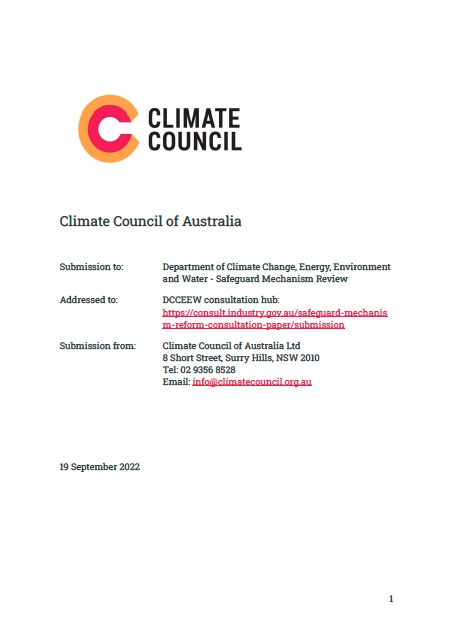We thank the Federal Government and the Department of Climate Change, Energy, Environment and Water for this opportunity to help strengthen the Safeguard Mechanism to enable dramatic emissions reductions this decade.
Our submission is based around three key principles for the reform of the Safeguard Mechanism. These are:
- To build confidence in the scheme, it must demonstrate the highest levels of integrity, transparency and accountability.
- To realise deep emissions reductions this decade and realise the scheme’s potential, baselines must be set to enable the highest possible ambition.
- To avoid locking in high emissions and to maintain social licence and political feasibility, the scheme must avoid placing any ceiling on future ambition.
Australia plays an outsized role in driving the global climate crisis. On a per person basis, we are the most polluting nation in the developed world – even before considering the impact of our globally significant fossil fuel exports. Reflecting the urgency of the global climate crisis and Australia’s role in it, the Climate Council recommends that Australia set its sights on reducing greenhouse gas emissions to 75% below 2005 by 2030.
A reformed Safeguard Mechanism must not create any barriers to the Federal Government lifting its ambition in future years. When the Federal Government improves our Nationally Determined Contribution commitment through the Paris Agreement – as it will need to do in future – the emissions reduction effort to be delivered through this mechanism must increase in tandem.
Climate change is accelerating with deadly consequences for Australians through worsening extremes like floods, heatwaves and bushfires. To tackle this existential threat to Australia’s way of life, emissions must go down, so achieving absolute emissions reduction is the key measure of success for a reformed Safeguard Mechanism.
The facilities covered by the safeguard mechanism have played an outsized role in ensuring Australia’s emissions stay high in recent times. While reported emissions from most other sectors have either held steady or decreased, emissions from facilities covered by the safeguard mechanism have increased by around 25%. As Australians face a seemingly never-ending series of events linked to the climate crisis, it’s about time that these big polluters took steps to reduce their impact on Australian lives, livelihoods and the places we love.
The Safeguard Mechanism, in its current form, is not set up to deliver emissions reduction. While the scheme may have been enacted to avoid emissions increases from Australia’s largest emitters, the reality is that over the first five years of its operation emissions from covered facilities – our largest industrial emitters across all sectors, including coal and gas producers, manufacturing, mining and transport – have trended upward. At the same time, the annual quantity of Australian Carbon Credit Units surrendered under the scheme has gone backward. As such, while the scheme could play a valuable role in reducing Australia’s greenhouse gas emissions, realising this potential will be challenging. The recommendations provided in this Climate Council submission would turn the Safeguard Mechanism into a robust, credible and effective lever for strong emissions reduction, if implemented as a package.
Given the scale of the emissions reduction task facing Australia, we also urge the Federal Government to consider taking further steps alongside this reform process to encourage and incentivise genuine investment in clean technologies by Australia’s major industrial emitters. In particular, we encourage the Government to consider implementing a mechanism similar to the Energy Efficiency Opportunities Act 2006, which required major energy users to identify and evaluate practical opportunities to achieve energy efficiency. Running a scheme such as this alongside funding mechanisms available through the National Reconstruction Fund, the Powering the Regions Fund and other state and territory funding sources would provide practical support and incentives for major industrial emitters to invest in the genuine technology improvements which can drive down their emissions. Integrating these policy levers to create an emissions reduction clearing house would provide very substantial benefits to industry, positively bolstering the government’s use of direct regulatory levers through the Safeguard Mechanism. For more details, please refer to the Climate Council’s ‘PowerUp: 10 climate gamechangers’.
We look forward to engaging further with the Government, Department and Parliament through the process of redesigning the Safeguard Mechanism to make it a tool that drives Australia’s largest industrial facilities to decarbonise. The Safeguard Mechanism can help to ensure clean, resilient, future-proof industries employing Australians for generations to come, if we get it right.
